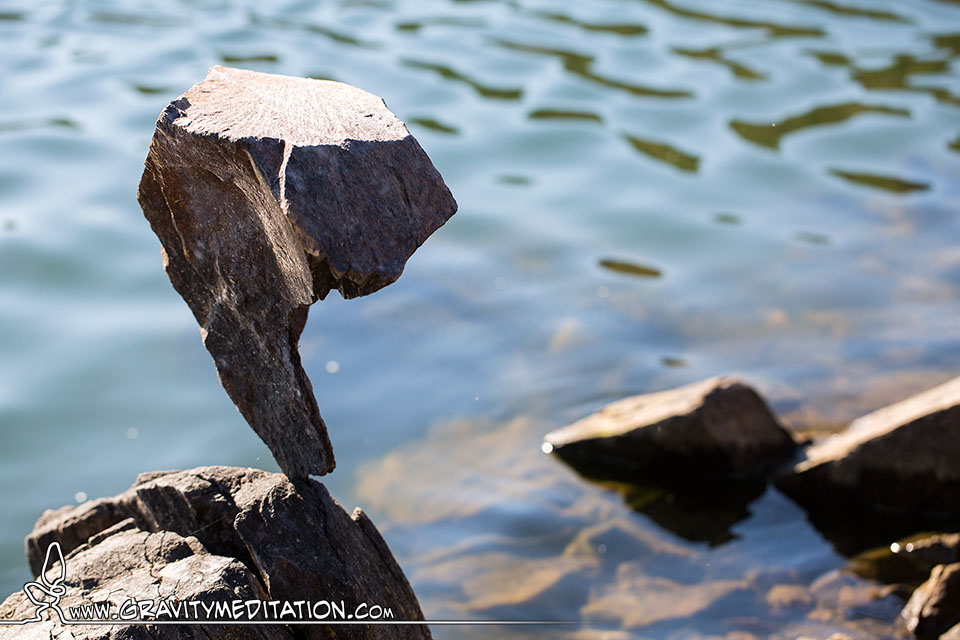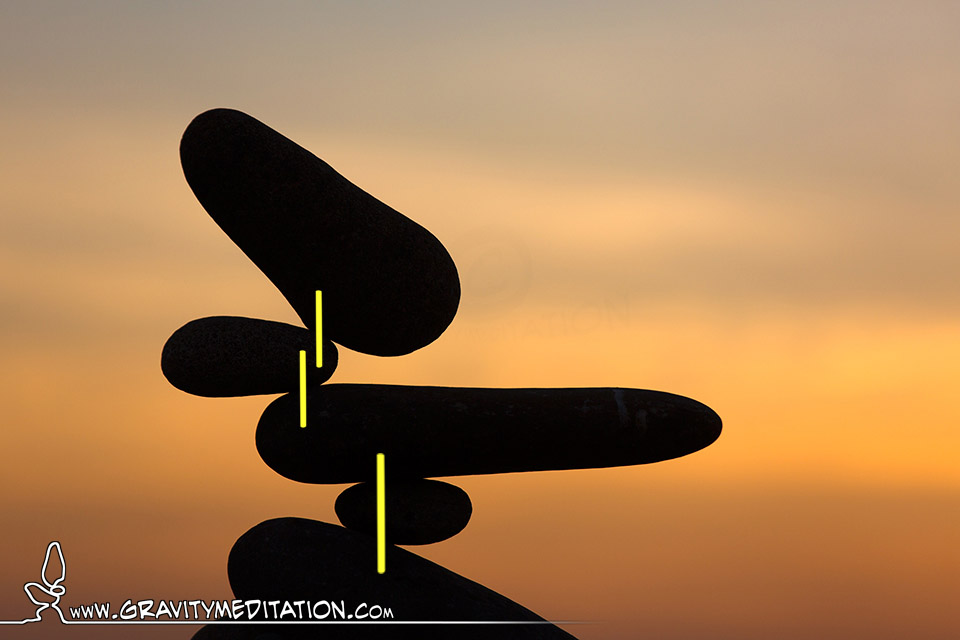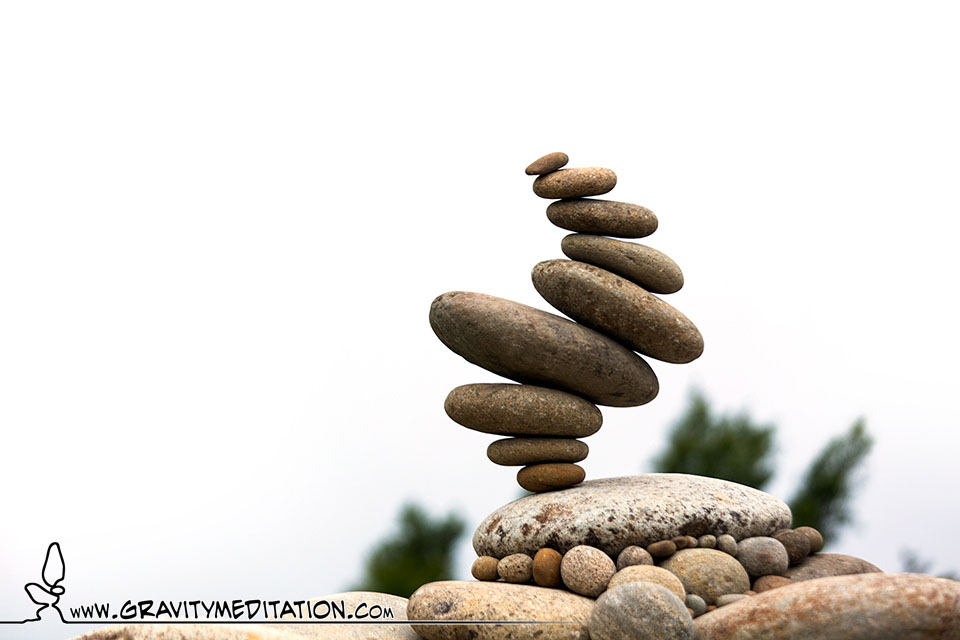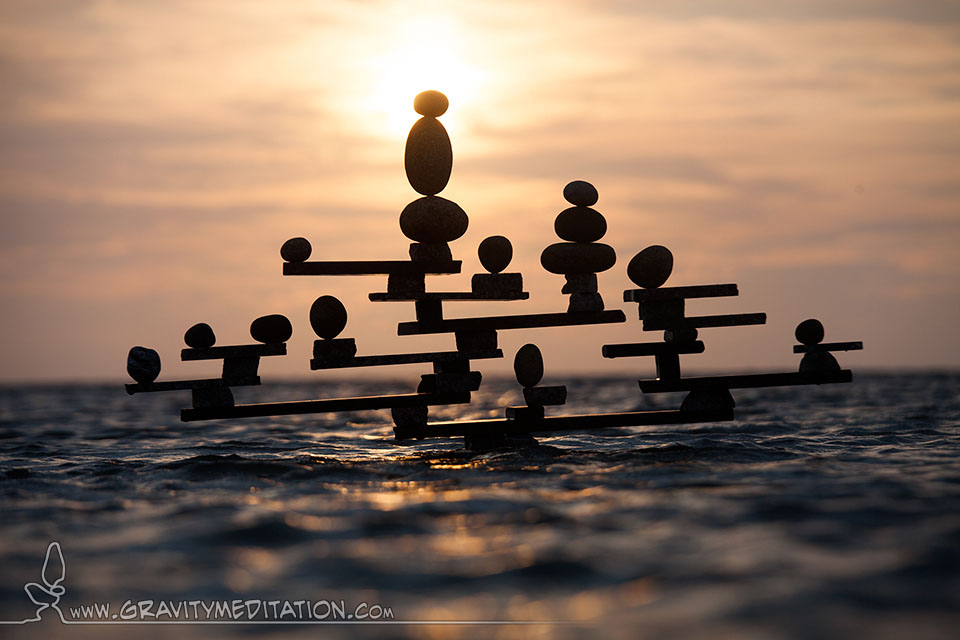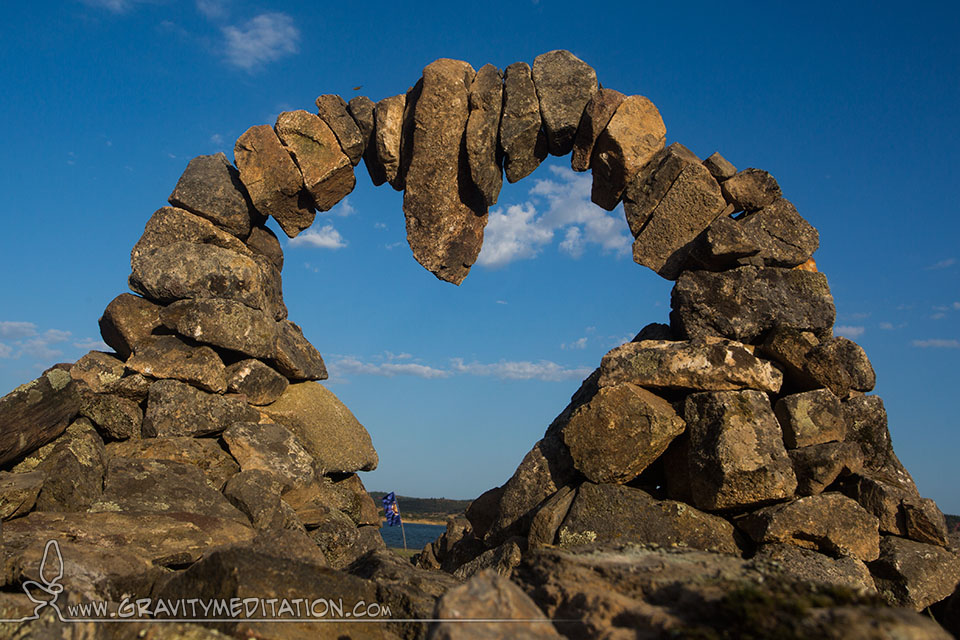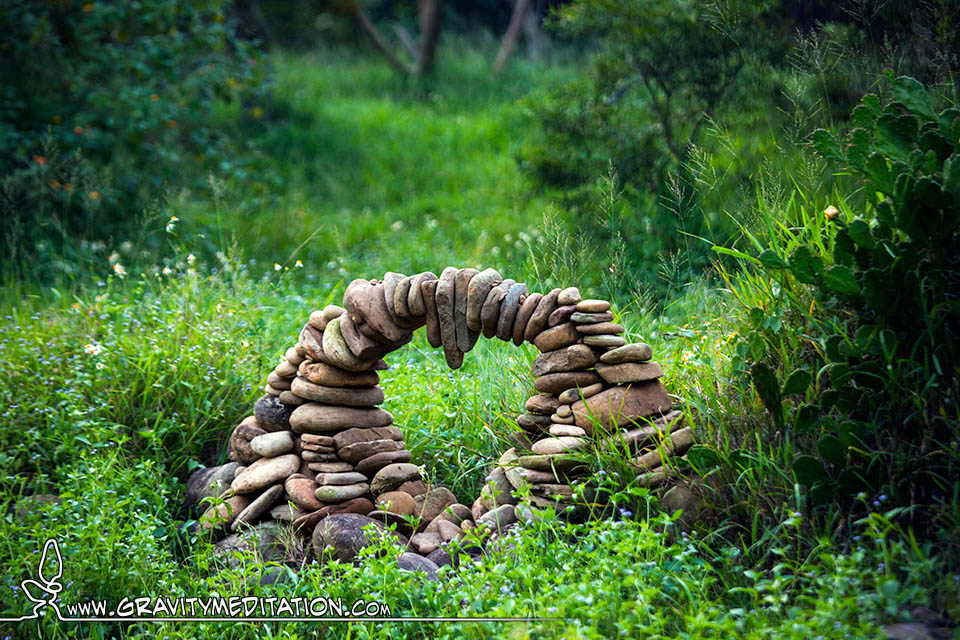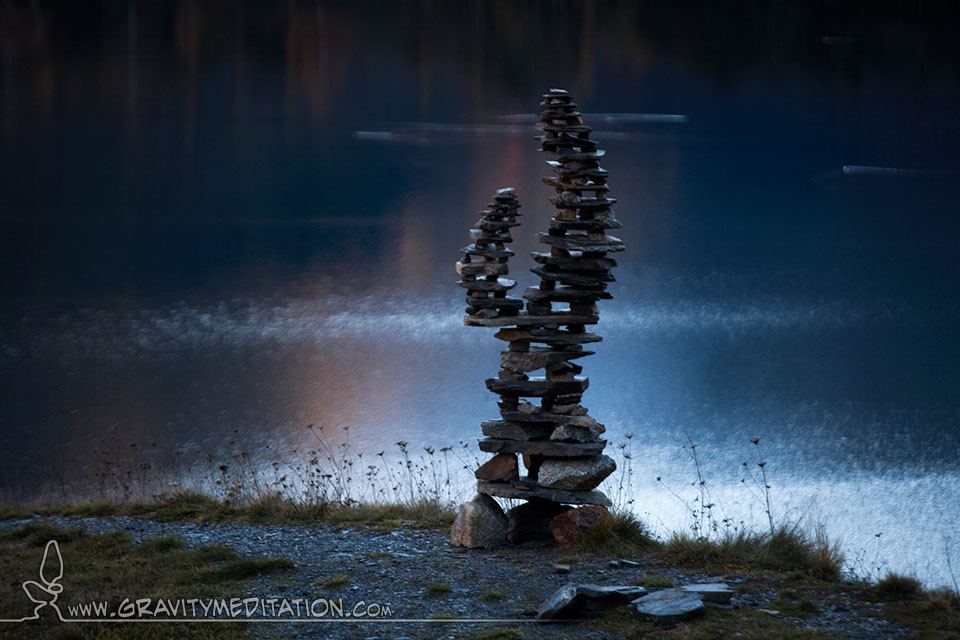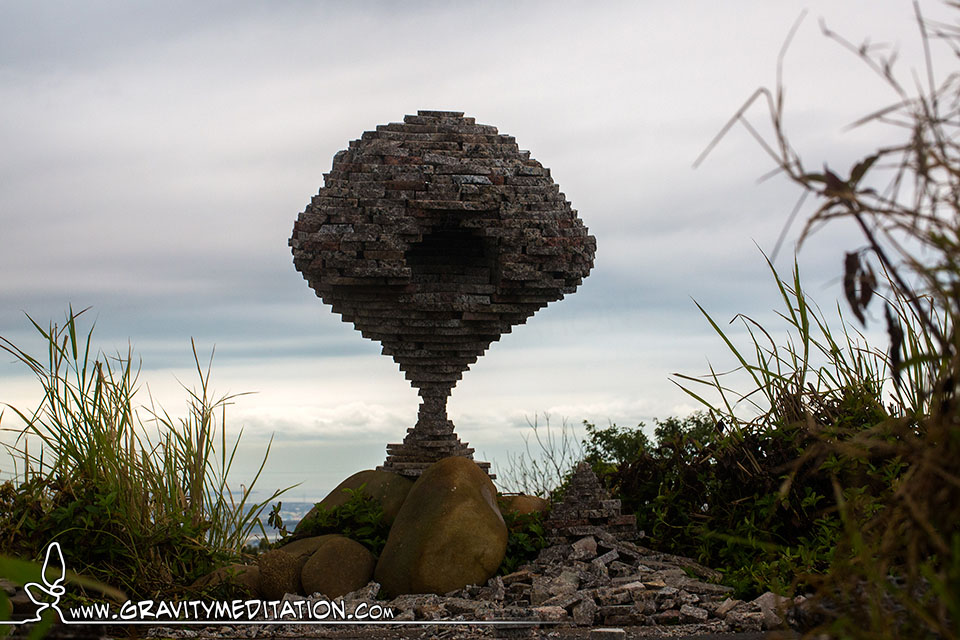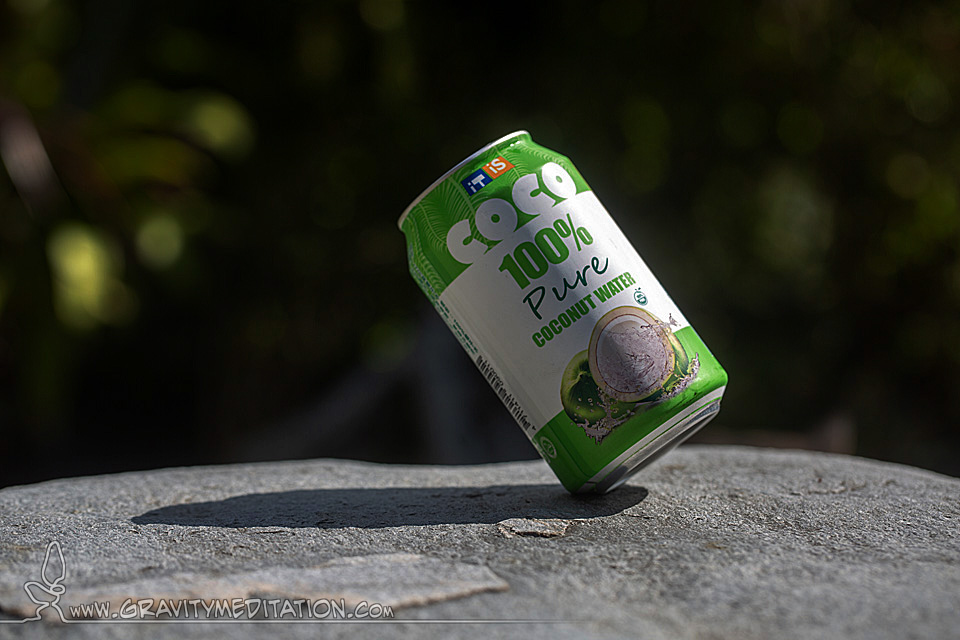A Introduction to
The Art Of Rock
Balancing
What is Rock Balancing?
When we talk of Rock Balancing or Stone Balancing we mean to put one or more rocks in a state of equilibrium where the rock’s contact point is kept very small. This sculptures appear often physically impossible while actually being only highly improbable.
It’s often mistaken with rock piling which in my opinion is not quite the same thing even such piles are also somewhat balanced, yet they usually touch each other on multiple contact points which are widely spread over the surface of the rocks.
Rock Balancing can be a play, a spectacle, a devotion, a performance or landart depending upon the interpretation by its practicioners and the audience.
Its also often seen as a active form of meditation which you can get lost in for hours. It comes with several benefits for the practitioner especially if its done for the pure joy of balanceing. That may change if it becomes a artistic job because in that moment another goal is added to this activity.
As long you keep it simple and you do it for fun only you will connect you with Nature in a very strong and unique way. Further more it encourages confidence, creativity and the knowledge of physical laws, it will also train you in sensitivity, patience and in letting go of things. Last but not least it is very calming and you will realise that it totally soaks you into the now, the big goal of meditation.
Now if I mentioned before that if you do it for other purpose than simple joy, I don’t mean that you wont benefit from it in that way but you bring another strong element into play which can make the whole venture very frustrating at times. The same happens if you start to compete with others, in both cases I think its actually also a chance to realise, accept and grow from this experience.
To let go of things in life is often not easy for humans because we attach our self’s to so many things, yet it can be very refreshing to overcome this fear of change which often lead to great new opportunities.
If it comes to Rock Balancing I look at it this way, if my work collapses I am challenged to do it again and so gain more experience. Of course it isn’t great from the perspective of a artist if my goal is to document this transient sculpture and it just disappears before I captured its short existence but if it happens I can’t change it and therefore the best way to deal with it is to see the opportunities in that situation rather than waste time in disappointment. Since this is a situation you will continuously experience as a rock balancer, I believe its a great lesson for other similar situations in life.
If it happens that you just balance for fun and your finished balance collapses because of a natural reason, e.g. wind, than don’t feel pity but joy because you mastered a unique alignment of elements which was so delicate that a bit wind was able to knock it over, that should be a approval of your skill and should not be taken as a failure. Frequently it’s other humans who bring a balance to its end because they can only imagine such a sculpture to be solid, it often looks impossible and to prove their judgement they will touch it. . Again I always take it as a compliment even it results in the end of the sculpture! Why? Because it again proves your skill, by the way the expression in those peoples faces is priceless.
Rock Balancing is a activity which gained much awareness in recent years, but it is actually a ancient practise which goes way back in time. At the end we wont know who balanced the first rock but I would not be surprised if it was a caveman. One of the most known artist of our time who balanced rocks is Andy Goldsworthy which inspired a whole generation with his stunning landart installations. His focus was not on rock balance, but on many different types of organic art.
Lately Rock Balancing increased its popularity also because of Michael Grab’s outstanding work went viral, it spread the web like no other artist in that field before him. This give that art form a real push and new balancers are popping up all over the globe.
I personally have seen that art form in its advanced level the first time in the late nineties at the shore of lake Zürich in Switzerland, where I had to laugh about the artist recommending me to try it my self. My replay at the time was “no way, what you are doing is crazy! I’ll never be able to do this myself!”, well I have proven myself wrong. Many people who come in sight of a rock balance sculpture consider it impossible at first.
Nowadays its me who recommend to try it and most people reply the way I did, but I am eager to convince them of at lest trying it. Its much easier than they think, most people balance a single rock under two minutes. Of course if you want to get fancy that requires much more practice, but that’s like with everything else in life! If you want to master something you need to work for it, or as Saadi a Persian poet once said “all things are difficult before they become easy”.

Rock Balancing – Stone Art
Different styles & techniques
Inline Balance
By a Inline Balance I refer to one or multiple rocks put into equilibrium with each rocks center of gravity align.
Most likely the first step of a Rock Balancer. After that advanced skills can be developed.
A multiple rock Inline Balance means the center point of each added rock is inline with all the others in a combination.
For Rock Balancing compared to staking and piling its the goal to keep the contact points as small as possible.
Counterbalance
This is the advanced style of Rock Balanceing and opens up a countless vaiarity of possible alighnments.
The usually unreal occurance of this sculptures makes it very popular among rock balancers.
In technical terms whats happening is that the lower rocks depend on the weight of what is placed on top of them to enter a state of equilibrium.
I would divide counter Rock Balancing into two categories, one is a inline counterbalance where the contact points are in one axis and another style where contact points trough the sculpture are clearly apart from each other.
If you merge the two you will have a “Twister” or “S-balance” that’s when the contact points are shifted but follow in total a linear structure.
Classic Arch
This is a ancient way of building with rocks, and to date its first kind most likely impossible.
To build a arch one must place a set of rocks between two sturdy points, they must together be wider than the distance between the two points. For it to work they must be placed in a bend between the two points, where the center rock is higher than the two points you conect.
In this category I refer to the clasical way building bridges where formers (scaffoldings) are used. To actually build big arches or bridges this is required but for small instalations its not a must. Still it is much easier to support the construction, one needs to be less organized at the beginning because there are always two hands free and the builder is able to leave the workspace during build up.
Balanced Arch
Contrary to the classic arch where you use utilities this approach is more challenging.
You use only your hands and the rocks to create the arch, the level of severity can still vary a lot depending on the rocks one uses. As flatter and rougher the rocks are as easier it will be to keep them in place.
Beside the building technique this arches do not differ from one another.
In both cases other rocks can be balanced on top of the arch to give a installation a additional splendor.
Rock Stack
Most of us who play with rocks must have started with this form of creation, stacking rocks on top of another to create tall structures. In my case that was the beginning of my artistic carier, more about it in the Gaia Gallery.
This rock towers are usualy robust and should last for a while if build carefuly. This structures are somewhat in balance as well, especially if they get tall, but I would not refer to as rock balancing.
There is no guideline to this structures, they are build in may diffrent ways. I usually use a 1/3 technice, in other words I alternate between one and three rocks at a layer. This makes them very solid.
Rock Pile
If I differ from rock staking and rock piling in this explanation than I would say staking has the main goal of height vs. piling the stability. But at the end this difference is made up by myself.
Rock piles, in some forms also called cairns can have many characteristics and are found all around the globe. They are build for many purposes such as trail markers, ceremonial purposes, to locate buried items, landmarks, art installations or simply for fun.
Rock Globe
This is where rock pilling meets rock balancing. In this type of sculpture one athemts to pile a huge amount of usually flat rocks on top of each other forming a round structure, but any other shape can be formed as well.
The main idea is to have a very small base and continue to gain a fair amount of width in the middle of the creation.
Bottle Balance
Many things can be balanced beside stones. One artist which immediately got my attention when I saw it the first time is Ly (Chú Lý Chơi Xếp Hình) from Saigon.
Glass bottles do offer interesting surface textures and cavities to use for balancing, but looking at the level of this creations it absolutely deserves to be mentioned here!
If you interested go visit Ly’s facebook page to see more of his amazing balanced glass bottle sculptures.
Can Trick
There’s a simple trick to balancing a can in the blink of an eye.
The key is to ensure the can is almost empty for the best results.
While classic 330ml cans work best, larger ones can also do the trick.
Make sure the remaining liquid is evenly distributed, with just a bit more weight on the side with the lower edge.
Give it a try … it’s surprisingly easy!

Spirit
● relax
● don’t compete
● always respect nature
● be patient and you will get there
● be conscious, rocks can harm you and others
● go new ways, boost your creativity
● let go when its time to
● push your limits
● never give up
● enjoy the art

Mother Nature

In some parts of the world
especially rock stacking became so popular that resistance has formed.
Now I am certainly not here to jump on that train but I would like to remind practitioners of some effects this practice can have on the environment.
- In general keep your impact to a minimal unless you know your action improves the health of Nature, e.g. collecting inorganic garbage and dispose is properly.
- Be aware that underneath rocks are often reptiles and insects at home, so be cautious and may leave a rock at its place if its the right thing to do.
- Removal of rocks especially in a big scale will lead to erosion, you can also turn it around and place rocks at specific pleases to help avoiding it.
- If you balance in public arias always take your balance down when you leave. You never know who comes by and may touch it, this can seriously harm people.
At the end it’s all up to you and how you judge the situation, I urge you to always respect Nature and not to create hazardous situations.
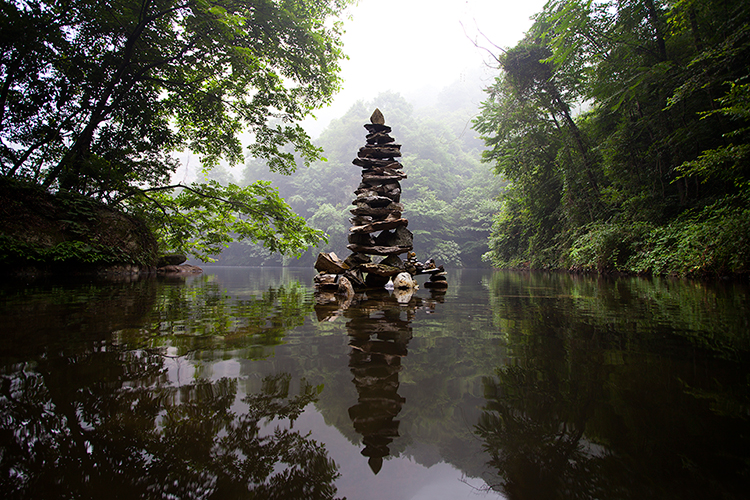


I hope this page has been inspiring and useful to you.
Creating and maintaining this platform requires considerable
effort and resources. If it has enriched your life, I would be
grateful if you’d share a coffee with me.

… or, what would make me even happier …
visit my shop and discover a creation that enriches your life
while supporting my work. I prefer this kind of exchange,
where you receive something tangible in return.




